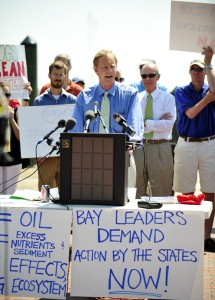11
Chesapeake Bay Dead Zone Up to 125 Miles Long

Dr. Mike Roman of the University of Maryland Center for Environmental Science talks about the growing concern surrounding the Chesapeake Bay's dead zones. (News21 photo by Jason Lenhart)
The Chesapeake Bay dead zone, an area so devoid of oxygen that nothing can survive there, now stretches 90 to 125 miles long and six miles wide every summer, said Dr. Mike Roman, lab director at the University of Maryland Center for Environmental Science. That comes to about 10 percent to 15 percent of the total volume of water in the bay.
Although shimmering and beautiful on the surface, “the water is more like pea soup,” Roman told News21.
Of the 10 most important commercial species of fish and shellfish in the bay, only crabs can tolerate these dead-zone conditions for short periods.
“Everything else dies or escapes,” said Yun Li, a UMCES graduate research assistant who specializes in physical oceanography modeling.
Nutrients like nitrogen and phosphorous as well as sediment that flush into the bay every year with spring and summer rains are feeding huge algae blooms that eventually suck all the oxygen out of the water, Roman said.
“That’s why we have to reduce the nitrogen and phosphorous” pouring into the bay, Roman said. Nitrogen, phosphorous and sediment are endemic to agricultural and storm water runoff that seep into rivers feeding into the bay from New York, Pennsylvania, Maryland, Delaware, Virginia and D.C.
Since passage of the 1977 Clean Water Act, the Environmental Protection Agency has worked to regulate discharges of pollutants into the waters, control the flow of those nutrients and improve the quality of waters across the United States, including the Chesapeake.
Roman has been studying the levels of dissolved oxygen in the both the Chesapeake Bay and the northern Gulf of Mexico for years and is one of the scientists heading down to the Gulf to analyze the water quality this summer.
About 50 percent of the nutrient-rich runoff pouring into the Chesapeake Bay comes from the Susquehanna, a river that starts in New York and runs through the Appalachian Mountains and farmland in Pennsylvania.
--By Sharon Behn
11
Environmentalist: Bay Faces ‘Death by a Thousand Cuts’
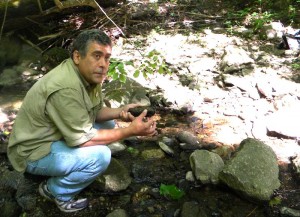
Environmentalist Tom Schueler describes the health of this small stream near Ellicott City, Md. (News21 Photo by Daniela Feldman)
ELLICOTT CITY, Md. – The Chesapeake Bay faces “death by a thousand cuts” unless regulators can reduce the amount of nutrients, metals and other pollutants carried into its rivers by stormwater, said environmental activist Tom Schueler.
Stormwater is the fastest-growing source of pollution in the Chesapeake Bay.
“The last three decades of steady suburban and exurban growth has greatly increased the amount of land that’s been paved over or the amount of turf cover that goes with it,” said Schueler, coordinator of the Chesapeake Stormwater Network, an environmental advocacy group.
Development in the Chesapeake Bay watershed – more roads, roofs and driveways – all prevent rainwater from being absorbed into the soil. Increasing amounts of pollutants flow off these developed lands and into streams and creeks.
Schueler said nutrients, trace metals, oil and grease are some of the pollutants carried in runoff.
He said tougher standards for new development – to reduce sediment and pollutant runoff – need to be put in place, and enforcement of industrial permits needs to be stepped up to prevent pollutants from coming into contact with rainwater.
He added, “If we don’t get serious in the bay watershed to have tougher standards, more enforcement, more frequent inspections and greater accountability, we’ll lose this resource.”
–By Allison Frick
7
Bay Scientist: ‘Nitrogen Is Our Oil’
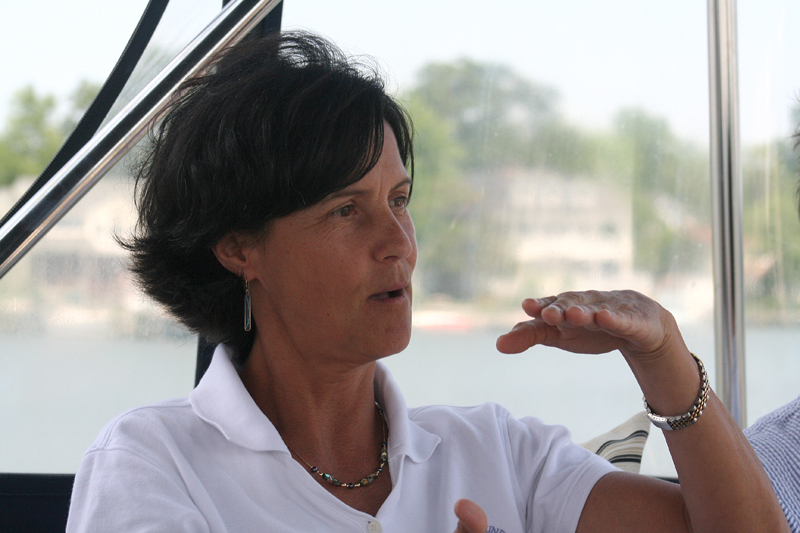
Dr. Beth McGee of the Chesapeake Bay Foundation compares the Gulf of Mexico's oil spill to the Chesapeake Bay's nitrogen surplus during a recent interview. (News21 photo by Brian Hooks)
The broken ecosystem in the Gulf of Mexico is a mirror image of the Chesapeake Bay’s dead zones and chronic decay, warned a leading water quality scientist, Beth McGee.
“Whether it’s impacted by oil, or whether it’s impacted by too much nitrogen, phosphorous and sediment, there’s a lot of similarities there,” McGee, who works for the Chesapeake Bay Foundation, told News21.
“I think it is in a sense that nitrogen is our oil,” McGee said, glancing over her shoulder at the glistening Severn River. McGee was traveling with a News21 team aboard the “Anonymous Source,” a 40-foot trawler owned by the editor of MadMariner.com, Glen Justice.
“If you look at the big picture in terms of resources being degraded because of water quality, we have a dead zone that makes a place where animals can’t live or can stress them to the fact that they are more susceptible to disease, which is exactly what oil does,” she said.
The slow pace of the Chesapeake Bay’s deterioration, taking place largely underwater, has led to little public outrage over the gradual disappearance of the estuary’s clear waters, fish and crab.
“I think that’s why they are not outraged: because it is beautiful. You look around, and the Bay on the surface is beautiful,” said McGee. Anyone would have to drop an oxygen probe to the bottom to see the that there is no oxygen there, she added.
“We’re not outraged because it’s not in our face, like it is in the face of the folks in the Gulf, where they can’t go fishing, they can’t buy seafood, they are seeing oil on their beaches,” McGee said.
–by Sharon Behn
4
Governors Call for Cooperation in Chesapeake Bay Cleanup
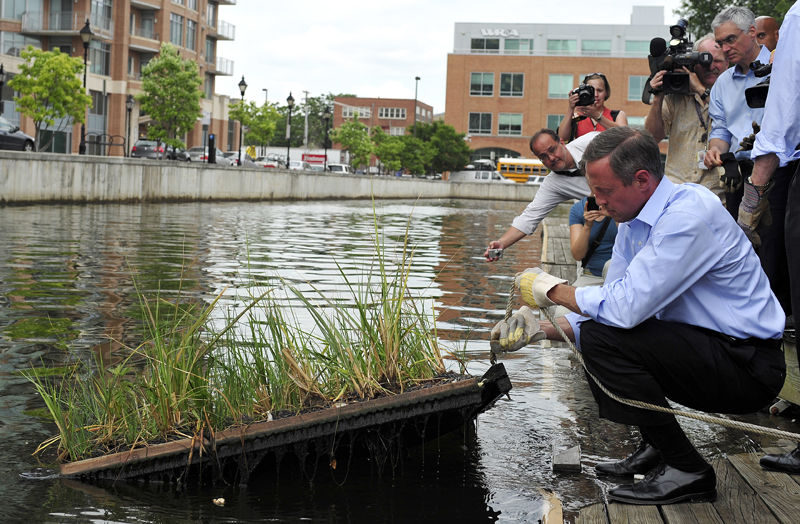
Maryland Gov. Martin O'Malley inspects a floating wetlands prototype before the press conference at the Inner Harbor Maritime Institute. News21 photo by Jason Lenhart
BALTIMORE — The governors of Maryland and Virginia yesterday joined D.C. Mayor Adrian Fenty in renewing calls for interstate cooperation in efforts to restore the Chesapeake Bay.
“There may be political borders that divide that watershed, but nature doesn’t recognize those borders,” said Maryland Gov. Martin O’Malley, after the annual meeting of the Chesapeake Executive Council.
Representatives from West Virginia, New York and Delaware also attended, though the three bay watershed states have no members on the Executive Council, which was created in the 1983 Chesapeake Bay Agreement between Maryland, Virginia, Pennsylvania and the District of Columbia.
“When it comes to our waters, we all know, from the governor of Virginia on up, that there are no borders,” said Baltimore Mayor Stephanie Rawlings-Blake, who welcomed the group. “The water runs from north to south, east to west, without consideration for jurisdiction or neighborhood or municipal border.”
But though the flags of all six states plus the nation’s capital fluttered in the breeze behind the politicians, no one from Pennsylvania was present. Gov. Edward G. Rendell, a member of the Executive Council, was meeting with the Pennsylvania Legislature about the state’s budget.
And EPA Administrator Lisa Jackson, the council chair, was also absent. She was in Louisiana dealing with the Gulf oil spill.
Though EPA Deputy Administrator Robert Perciasepe called increased transparency a hallmark of discussion during the meeting, the meeting itself was closed to the public.
And the speakers were reluctant to discuss the consequences and sanctions that could come for failing to meet cleanup milestones next year. Each state in the Chesapeake watershed has set goals to reduce nitrogen and phosphorus, the bay’s biggest pollutants, by December 2011. Recently, federal agencies said they would establish their own two-year milestones to complement state efforts.
The leaders focused at the press conference on the successes of their governments and agencies.
O’Malley and Virginia Gov. Bob McDonnell highlighted their state’s restrictions on harvests of blue crabs that helped cause a 60 percent rebound in the crab population from last year to this one.
O’Malley and Perciasepe spoke of the strides made in combining forces and sharing information with the public, especially the unveiling of ChesapeakeStat, a one-stop website for progress reports on restoration efforts across the expansive watershed. ChesapeakeStat is based on BayStat, started three years ago by Maryland’s government.
“I think we are entering an era of action in holding ourselves accountable for real, measurable results,” Perciasepe said. “The bay is an emotionally and culturally connected water body to the entire region, and it is vitally important to the 17 million people who live in this watershed that this multi-agency, multi-state process continue as strongly as possible.”
The level of progress toward cleanup goals has varied. Maryland has already reached its goal of maintaining 150,000 acres of no-till farming but has made no movement on its promise to transport 10,000 tons of manure out of the watershed area. But O’Malley remained optimistic even about the failures.
“There is a rhyme and a reason for picking those two-year milestones,” O’Malley said. “It’s so that all of us know where we’re succeeding and where we’re falling short, so that all of us hopefully can contribute to making sure that we hit those goals and the long-term goal of a much healthier bay.”
– by Kate Yanchulis
2
Bay Pollution Akin to Gulf Oil Spill, Advocate Says
ANNAPOLIS – A top environmental official on Wednesday compared the pollution flowing daily into the Chesapeake Bay to the massive oil spill in the Gulf of Mexico that threatens to destroy the livelihood of thousands of Gulf residents.
“We have a Gulf oil spill right here on Chesapeake Bay that’s a constant, insidious poisoning of another national treasure,” said William C. Baker, president of the Chesapeake Bay Foundation.
“Every single day nearly a million pounds of polluting nitrogen flow into the Chesapeake – every day, 24/7, 365 days a year,” he said at a small gathering of Bay scientists, activists and former politicians at the Annapolis City Dock.
The group had gathered to call for stronger work to clean up the Bay, one day before a major meeting of the Chesapeake Executive Council in Baltimore.
The environmental disaster in the Gulf, Baker said, was not only a crime against nature, but a “crime against humanity that is unfolding even as we speak.”
The Chesapeake Bay Foundation is a nonprofit advocacy group focused on restoring the Bay and its tributaries.
–by Sharon Behn
2
Bay Activists Call for Stronger Cleanup
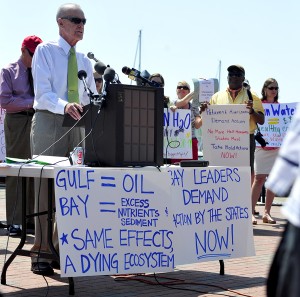
Former Maryland State Sen. Bernie Fowler, backed by top Chesapeake Bay leaders, at the Annapolis City Dock. Fowler compared the Bay cleanup efforts to the last leg of a 400-meter race. Photo by News21
ANNAPOLIS – A small flotilla of boats sailed into the City Dock Wednesday morning, bringing a group of Bay activists, scientists and former politicians to a rally calling for new actions to restore the Chesapeake Bay.
The few dozen activists released a 25-point plan aimed at stopping the decline of the Chesapeake. The plan outlines stronger cleanup measures to reduce the amount of pollutants from agriculture, land development, septic systems and air emissions that reach the Bay.
More than 50 individuals from Maryland, Virginia and Pennsylvania signed the plan as a demonstration of their belief that the voluntary efforts at cleaning up the Bay for the past 26 years have failed.
“We are trying to create a new day for the Bay,” said former Maryland state Sen. Gerald Winegrad, the event organizer.
The Bay Flotilla comes the day before a major meeting of officials in Baltimore at the Chesapeake Executive Council meeting.
Activists called on the Environmental Protection Agency, which will be sending a representative to the meeting tomorrow, to help the six states in the bay’s watershed.
Former Maryland state Sen. Bernie Fowler said that tomorrow, the baton will be passed to the EPA. “All we’ve got to say to the EPA,” Fowler said, “is for God’s sake, when you get it in your hand, run – and don’t you drop it. We cannot afford to lose this wonderful Bay.”
–by Alex Moe






